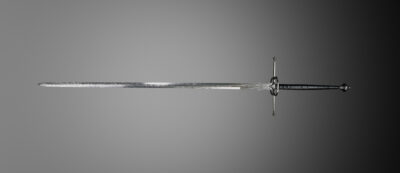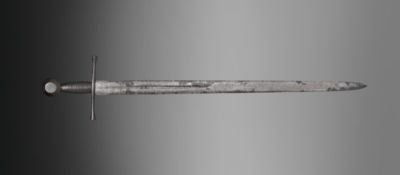Blog
The Bastard Sword: A Versatile Weapon

This sword is titled a bastard sword. It’s famous for being usable in variant scenarios, having a unique design, and having a long history of being used in battles. Another reputation for it is a hand-and-a-half weapon because you could use it with one hand. But the handle is longer so that you can use it with both hands and generate more power. Since it can be utilized one or two-handed, it doesn’t quite fit into the one-handed or two-handed aggregation, which is why they call it a “bastard sword”, around the 1500s.
A Weapon of Duality: Understanding the “Bastard” Moniker
The strange name of the bastard sword is worth focusing on prior to diving into its intricacies. Previously, it was known as the “hand-and-a-half sword” or simply the “longsword,” although the term “bastard sword” is still in use. Its origins can be traced back to its hybrid design, which falls between one-handed and two-handed swords. Ascending to conspicuousness in the fifteenth and sixteenth hundreds of years, it represented an unrest in weaponry during the late medieval era. Balancing perfectly, it allows effective single or dual-handed wielding, marking it distinct from its counterparts.
Two-Handed Sword 1550–1600 Spain, Toledo (?), second half of 16th Century credit: The clevelandar
Blade: The blade of the bastard sword typically features a double-edged and straight design, enabling it to perform both thrusting and cutting actions. Lengths going from thirty to forty inches take into consideration comfortable use with both one-gave and two-gave grips. Blade profiles vary, featuring sharp points for thrusting or broad tips for cutting. Cross-sections range from flat to diamond-shaped, impacting rigidity and cutting performance, influenced by historical periods and regional styles.
Hilt: The hilt of a bastard sword features a cross-shaped guard, crucial for hand protection and parrying. The pommel, situated at the hilt’s base, serves to balance the sword and acts as a counterweight during strikes, enhancing its defensive and offensive capabilities.
Grip: The bastard sword’s long grip feels great in one hand but allows for two-handed power. This makes it useful in many different fighting situations. Craftsmen can make handles from various materials such as wood, leather, or wire. They keep the sword secure and look nice. Crafting the handle is crucial for ensuring the person using it stays safe and maintains control during a fight.
Bastard Swords vs. Longswords:
During the 14th century, the arming sword became a versatile weapon for knights and soldiers – Credits: The Cleveland Museum of Art
There are subtle distinctions between bastard swords and longswords. Longswords, typically defined by their hand-and-a-half grip, prioritize versatility like the bastard sword. However, the bastard sword tends to be slightly shorter and potentially more robust, offering a better balance between maneuverability and power. This slight difference might have made the bastard sword a preferable choice for mounted combat or situations where frequent switching between one and two-handed use was necessary. Ultimately, both swords were formidable tools for medieval warriors, with the “bastard” name reflecting its ability to defy categorization and excel in both one and two-handed combat.
Bastard Swords vs. Great Swords
The arming sword, also known as the knightly sword, was a one-handed sword often used with a shield. It came from Viking swords and was used widely in Europe, especially by Crusaders and Templars, for slashing blows against chainmail armor. Although the arming sword was meant to be used with one hand, the bastard sword, which fell between one-handed and two-handed swords, had a similar blade length. Bastard swords worked much like arming swords when held with one hand, though the balance was a bit different. Their longer grip allowed for two-handed use, delivering stronger blows against armored foes.
Bastard Swords vs. Arming Swords:
The arming sword, also known as the knightly sword, was a one-handed weapon commonly paired with a shield, originating from Viking swords and widely used throughout medieval Europe, especially during the Crusades. It was designed for slashing blows against chainmail armor. The bastard sword, falling between one-handed and two-handed swords, shared similar blade lengths with the arming sword but featured a longer grip, enabling both one-handed and two-handed use. While it could be wielded with one hand like the arming sword, its extended grip facilitated more powerful strikes against armored adversaries when used with both hands, albeit with a slightly different balance.
Weight, Balance, and Historical Significance:
Skilled swordsmiths meticulously considered the weight and balance of the bastard sword during crafting. Achieving the perfect equilibrium between weight and maneuverability was paramount for its effectiveness. Typically weighing between 2.5 and 4.5 pounds, the sword balanced power and agility. Its balance point is usually a few inches from the crossguard. Facilitated seamless transitions between grips, enhancing versatility and control in combat. In medieval Europe, knights, men-at-arms, and even civilians wielded this weapon, symbolizing ideals of chivalry and knighthood. Martial treatises from masters like Fiore dei Liberi and Joachim Meyer documented combat techniques. Elevating the bastard sword’s historical significance beyond its practical utility.
The Bastard Sword in HEMA:
In HEMA, which stands for Historical European Martial Arts, we have different names for what we now call longswords. These include the bastard sword, hand-and-a-half sword, and estoc. Longswords are lightweight enough to use with one hand but have a long grip for using both hands. They usually have blade lengths of around 33 to 40 inches and grip lengths of 7 to 10 inches.
Even though there are different types of longswords, they all use the same techniques. Their size, hilt shape, grip, and cross-section don’t change the techniques much. Bastard swords are especially good for half-swording, close-range thrusting, and fighting in armor.
A Modern Revival: The Legacy Continues
The bastard sword has had a resurgence in popularity recently because to the growing enthusiasm with Historical European Martial Arts (HEMA). Historians, martial artists, and enthusiasts are all actively researching
Conclusion:
During the 15th and 16th centuries, the bastard sword served as the quintessential knight’s weapon, boasting a unique grip suitable for either one or two-handed use. While the hilt designs evolved over time, the sword retained its versatility. Today, known also as the hand-and-a-half sword, it holds prominence among practitioners of Historical European Martial Arts (HEMA), military scholars, and enthusiasts for its historical significance and adaptable combat capabilities.

